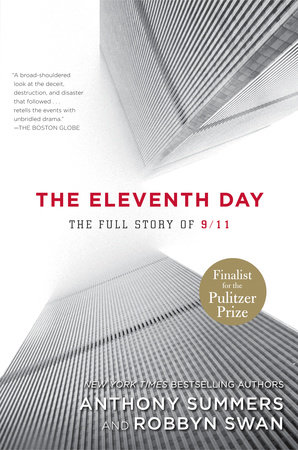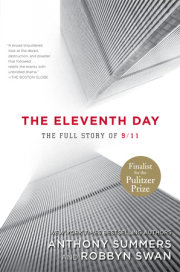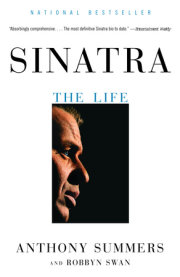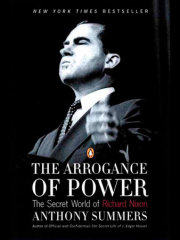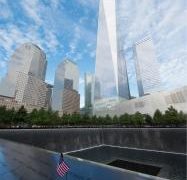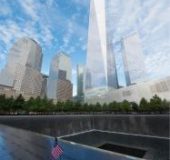ONE
Did the story begin twenty years ago during the Gulf War, when a great American army was installed in Saudi Arabia, a land sacred to Muslims? Did it begin in 1948, when the United States recognized the declaration of a Jewish state to be known as Israel? Or on the day in 1938 when Americans discovered in Saudi Arabia one of the largest reserves of oil on the planet? From then on, certainly, the West began an addictive dance with danger, one that it dances to this day.
This is a story, moreover, rooted in a world and a culture that few Westerners really know or can begin to understand, yet played out in the heart of the United States. Mystery and terror, a frightening mix. Yet there is a simple point of entry, a routine event on an ordinary American morning.
In the dawn of September 11, 2001, in Massachusetts, ninety-two people were getting up, breakfasting, heading for Boston's Logan Airport. They were the passengers and crew of American Airlines Flight 11, one of some forty thousand planes scheduled to crisscross the country that day.
To glance at some of the names on the passenger manifest, to learn a little about them, is to glimpse the melting pot nature of the country. Philip Rosenzweig, an executive for Sun Microsystems; Thelma Cuccinello, a grandmother on her way to see a sister in California; Peter Gay, a vice president for Raytheon Electronic Systems, traveling with two colleagues; Laura Lee Morabito, U.S. sales manager for the Australian airline Qantas; photographer Berinthia Berenson, widow of the actor Anthony Perkins; David Angell, executive producer of the television series Frasier, accompanied by his wife, Lynn; Jeffrey Mladenik, an ordained minister and acting CEO of a trade publishing company; Lisa Gordenstein, an executive with a discount clothing company; Michael Theodoridis, on his way to a wedding with his wife, Rahma, who was six months pregnant; Walid Iskandar, a business strategy consultant for a British company, setting off to visit his parents; Alexander Filipov, a retired electrical engineer; Daniel Lewin, chief technology officer for Akamai Technologies in Cambridge, Massachusetts. Also on their way to the flight were five young men from the Middle East, an Egyptian and four Saudis.
The pilot who was to fly these people to California, John Ogonowski, flew twelve days a month and worked the rest of the time on his 150- acre farm. At fifty, he was a veteran of twenty-three years with American, married to a flight attendant. He had hoped to attend a farming event on the 11th, but the schedule proved unchangeable. At 5:00 that morning Ogonowski awoke, kissed his wife, peeked in at their three sleeping teenage daughters, and climbed into his pickup to drive to the airport. His copilot that day would be Tom McGuinness, a former Navy fighter pilot.
Flight 11, a "turn-around"-an airplane that had flown through the night from San Francisco-was parked at Logan's Gate 32. Captain Ogonowski arrived to a scene of busy activity. The cleaners were working their way through the plane, the fuelers delivering 76,000 pounds of jet fuel. The nine flight attendants in their blue uniforms were gathering.
Karen Martin, in First Class, was in charge. At forty, she was renowned for her efficiency-"organized_._._._on the stick to a fault." Her backup, Barbara "Bobbi" Arestegui, was diminutive-small enough, crews joked, to fit on the luggage rack. Several colleagues who had been scheduled to fly were not on board. One had called in sick, another had switched to a different flight-she wanted to accompany her father to a doctor's appointment. Two others, waiting on standby, were told they were not required.
The check-in process went normally. No one knew until later that, even before they reached the terminal, three of the Arab passengers had been involved in an odd incident. A driver next to them in the parking lot would remember how they had dawdled, leaving the door of their rental car open, "fiddling with their things." Irritated, he pushed at the offending door, shoved it against one of the Arabs, half expecting a shouting match. Instead, studiously avoiding a scene, the three Middle Easterners said not a word.
In the terminal, though, the check-in attendant found only passenger Filipov, the electrical engineer, to be acting out of the ordinary. He seemed nervous, paced up and down, seemed to know nothing of airport procedure. The attendant found it a little "suspicious." Otherwise, no one else's behavior caught her attention.
The copilot of the incoming flight, however, deplaning as the fresh crew took over, would remember a strange encounter. As first officer Lynn Howland left the airplane an Arab man stopped her to ask if she would be piloting the soon to depart Flight 11. When she said she would not, he turned away in an "extremely rude" way. Later, shown a picture of the Egyptian passenger on Flight 11, she at once identified him as the man who had approached her.
At check-in, a computer profiling system had selected three of the five young Arab passengers as potentially suspect. Their checked baggage was screened for explosives, the men themselves given special scrutiny by security. Like the carry-on bags of all passengers, theirs were X-rayed. Nothing was spotted.
All five young Arabs, one reportedly carrying a wooden crutch, then proceeded to the gate. One of them-the Egyptian, the agent thought- arrived "sweating bullets_._._._his forehead was drenched." With no good reason to stop him, she handed the man his boarding card. He and a companion were the last to board, there to be greeted by senior attendant Karen Martin.
The Egyptian settled down in First Class in aisle Seat 8D, next to passengers David and Lynn Angell. One of the Saudis sat next to him. Two of the others sat further forward, near the cockpit, next to Laura Lee Morabito. Another sat directly behind Daniel Lewin.
The food was on board by now, the in-flight movies loaded. Her final checks completed, Karen Martin prepared to recite the airplane's safety features. Her colleague Madeline Sweeney, whom everyone knew as "Amy," had grabbed a few moments to call her husband. She wanted to say she was sorry not to have been able to see her five-year-old daughter off to kindergarten. Now, though, it was time to switch off all cell phones.
Flight 11 pushed back from the gate at 7:40 and by 8:00 it was soaring skyward. September 11 was a glorious morning for flying, with virtually no cloud or wind-"severe clear" in pilots' parlance.
The Air Traffic Control transcript of air-to-ground exchanges shows that Flight 11 flew routinely for thirteen minutes. "Departure. Good morning. American 11 heavy with you," Captain Ogonowski told Boston control. "Passing through, ah, 2,000 [feet] for 3,000." Boston alerted him to a small Cessna nearby, asking him to climb and turn right. Then, with a "So long," management of Flight 11 passed to other controllers.
The laconic back-and-forth continuing, Ogonowski climbed his plane toward its assigned altitude of 29,000 feet. Then, just after 8:13, Federal Aviation Administration controller Pete Zalewski, at Boston Center-one of the FAA's twenty-one Air Route Traffic Control Centers- told the pilots to turn twenty degrees to the right. "20 right. American 11," a pilot acknowledged, and the plane turned.
Sixteen seconds later, when Zalewski told them to climb, Flight 11 did not reply. The controller would try again and again for the next eleven minutes. "American one one_._._._do you hear me? _._._._American eleven, if you hear Boston Center, ident please_._._." Only static came back across the ether, with one exception-later to be logged as "a brief unknown sound (possibly a scream)."
At 8:18, unbeknownst at the time to the controllers, a telephone rang at an American Airlines office almost a thousand miles away, in the town of Cary, North Carolina. Vanessa Minter, an employee accustomed to dealing with calls about reservations, heard a woman's voice say, "I think we're being hijacked."
Flummoxed, failing to find the emergency button on her phone, Minter transferred the call to a colleague. He did press the button, automatically starting a recording, and brought in a supervisor named Nydia Gonzalez. Soon Gonzalez was passing on what she heard to American's security office in Texas.
The woman calling was a senior Flight 11 attendant, forty-
five-year-old Betty "Bee" Ong. Using a seatback Airfone, Ong had dialed a number that crews knew well-they used it to help passengers with onward travel plans. She sounded "calm, professional, and poised," and we know exactly what she said for four and a half minutes, the standard duration of the recording system. The rest of the conversation-Ong talked for about twenty-eight minutes-is as remembered by the employees who dealt with the call:
Ong: [I'm] number 3, in the back. The cockpit's not answering. Somebody's stabbed in business class and, ah, I think there's Mace that we can't breathe. I don't know. I think we're getting hijacked.
The seconds ticked by. Time was lost as the staff on the ground asked repetitive questions, mostly to confirm Ong's identity. Then:
Ong: _._._._Somebody is coming back from business_._._._hold on for one second_._._._Karen and Bobbi got stabbed. [This last sentence, the tape shows, was spoken by a fellow attendant close by.]_._._._Our number 1 got stabbed_._._._our galley flight attendant and our purser has been stabbed. And we can't get into the cockpit. The door won't open.
An airline employee on the ground made an unhelpful interjection. "Well, if they were shrewd they would keep the door closed_._._._Would they not maintain a sterile cockpit?"
"Karen" was lead flight attendant Karen Martin, "Bobbi" her backup Barbara Arestegui. Martin, Ong said, lost consciousness, then came around and was being given oxygen. Arestegui appeared not to be seriously injured. The passenger in First Class Seat 9B, however, appeared to be dead.
The man in Seat 9B had perhaps tried to intervene and fight the hijackers. He was Daniel Lewin, an American-Israeli who had served in a crack Israeli commando unit. Lewin spoke Arabic, and may have understood before anyone else what the hijackers intended. Ong said the passenger in Seat 10B, directly to his rear, had stabbed Lewin to death. The man in 10B was one of the five young Arabs who had boarded that morning. The killer and another hijacker, Ong said, had gotten into the cockpit. The sound of "loud arguing" had been heard.
Four minutes into the call, Ong's colleague Amy Sweeney began trying to phone American Airlines back at the airport in Boston. At 8:32, using a borrowed calling card, she began speaking with duty manager Michael Woodward.
Sweeney, who also reported the stabbings, said the hijackers had "boxes connected with red and yellow wire"-a bomb, she thought. One, she said, spoke good English. So far, passengers in Coach seemed unaware of what was going on.
If the cockpit door had been locked, as required by FAA rules, how had the hijackers gotten in? All American flight attendants held keys, and that was almost certainly why the attendants in First Class- Martin and Arestegui-had been attacked.
There is no knowing exactly what happened when the hijackers erupted into the cockpit. "There was no warning to be more vigilant," Captain Ogonowski's wife, Peg, would later say. "These people come in behind him. He's sitting low, forward, strapped in-the same with his copilot. No warning_._._."
Ogonowski and copilot Tom McGuinness had been trained not to respond to force with force. FAA policy was still geared to hijackings designed to take over airliners, not destroy them. It called for pilots to "refrain from trying to overpower or negotiate with hijackers, to land the aircraft as soon as possible, to communicate with authorities, and to try delaying tactics." According to an FAA security report, the agency did know that "suicide was an increasingly common tactic among terrorists in the Middle East." Its brief to its pilots, however, offered no guidance on how to deal with hijackers bent on suicide.
Attendant Ong had not sounded panicky as she reported from Flight 11. From time to time, though, she asked staff on the ground to "Please pray for us." There were moments, she said, when the plane was being flown erratically, "sideways." It was descending. The phone line had started to fade in and out. Her colleague Amy Sweeney said she could see they were now "over New York City."
Then Ong exclaimed, "Oh, God!_._._._Oh, God!_._._." and began to cry. Sweeney screamed and said, "Something is wrong. I don't think the captain is in control. We are in a rapid descent_._._._We are all over the place_._._._I see water! I see buildings!_._._." Next, a deep breath and, slowly, calmly, "Oh, my God!_._._._We are flying low. We are flying very, very low. We are flying way too low." Seconds later, again, "Oh, my God, we are way too low_._._."
American Airlines' people on the ground could no longer hear either flight attendant. In Boston, duty manager Woodward got only "very, very loud static." In North Carolina, Gonzalez was saying, "Betty, talk to me. Betty, are you there, Betty?_._._."
And finally, "I think we may have lost her."
TWO
I
t was just over half an hour since the hijackers had struck.
In an office in Lower Manhattan, high in the North Tower of the World Trade Center, a data processor glanced up from his computer. On the horizon to the north, a dot in the sky got his attention. Unusual to see a plane over there, he thought, and turned back to his work.
Moments later, from his perch on a structure on East 77th Street, a steelworker was startled by the sight and the roar of an airliner flying so low that-it seemed to him-it almost hit the antenna atop the Empire State Building. At Madison Avenue and 45th Street, construction workers stared in astonishment. In SoHo, twenty blocks north of the Trade Center, a composer seated in a restaurant window heard a jet thunder overhead. Pigeons, normally blasé, rose in alarm. A window-gazing student at Stuyvesant High-on the banks of the Hudson River-glimpsed the plane for a second and blurted a stunned, "Did you see that?"
A "freakish noise" sent author-photographer Lew Rubenfien rushing onto the roof of his apartment building.
It was the sound jet engines make on a runway when they have been powered all the way up for takeoff-though much more violent, somehow enraged._._._. The plane was moving far faster than you ever saw one go so low in the sky._._._. I began to shout telepathically, "Get away from the building, get away from the building."_._._._The plane made a perfect bull's-eye, leaving a jagged tear_._._._and then, just as it happens in dreams, everything stretched a long way out._._._. There could only have been a fraction of a second._._._. Then, at last, the building exploded. Hot and orange, the great gassy flower blew out.
It was 8:46 a.m.
The impact had been caught on film thanks to the snap reaction of French documentary maker Jules Naudet, filming nearby with a unit of the New York Fire Department. "I look up, and it's clearly an American Airlines jet," the Frenchman said later. "I turned the camera toward where it was going to go_._._._I see it go in. I'm filming it." The image he shot, destined to become iconic, precisely matches Rubenfien's verbal description-orange burst at the core, great bloom of gray smoke or vapor to the left.
Copyright © 2011 by Anthony Summers. All rights reserved. No part of this excerpt may be reproduced or reprinted without permission in writing from the publisher.

